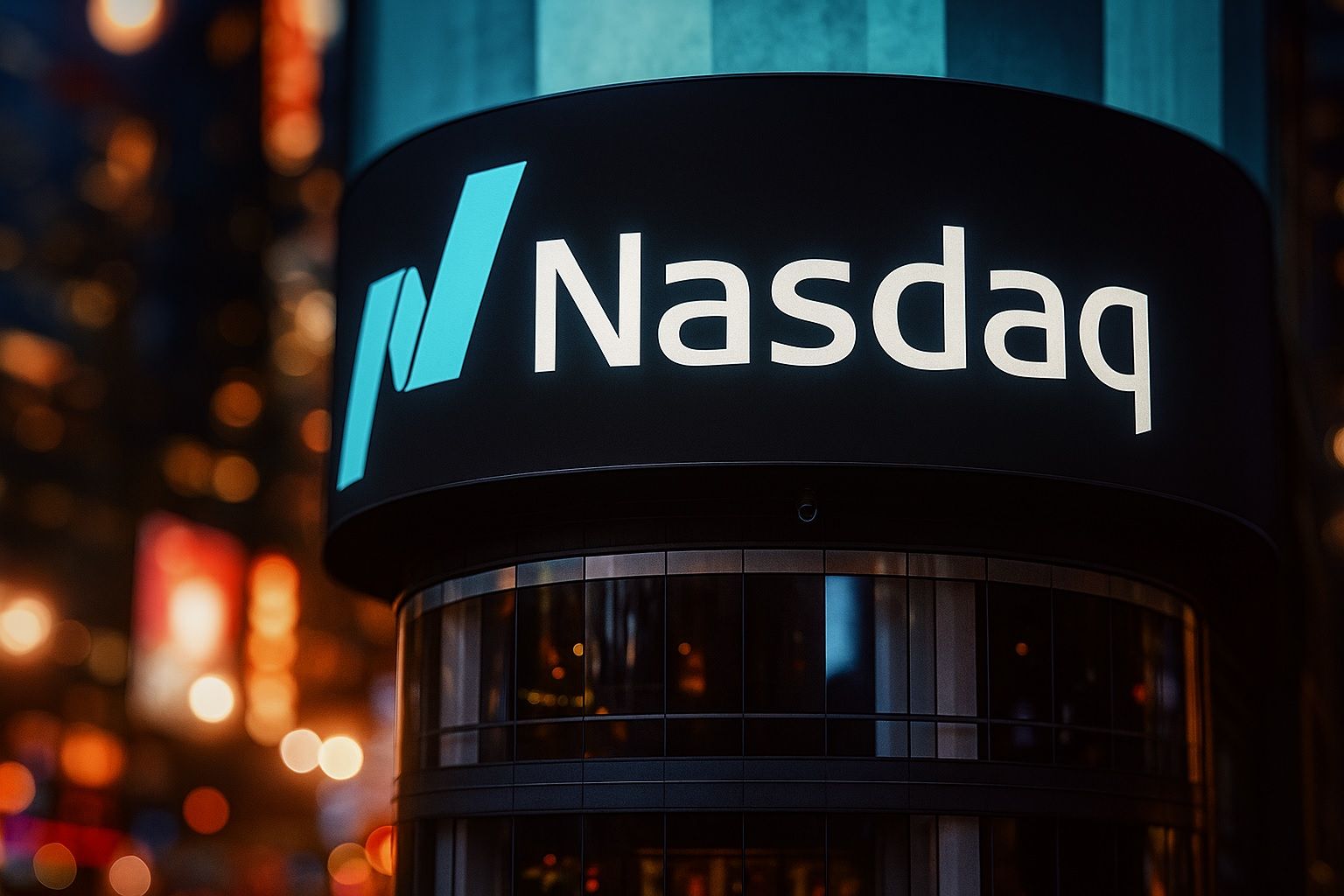- Blowout Big Tech Earnings: Amazon’s stock surged ~13% after a Q3 earnings beat, with cloud sales jumping 20% YoY [1] [2]. Apple’s shares hit ~$271 (↑3.7%), nearing a $4 trillion market cap, on record iPhone sales and an upbeat holiday forecast [3] [4].
- Market Rally Reignited: The S&P 500 rebounded ~0.7% Friday, set for a 6th straight monthly gain, as Amazon and Apple’s strong results rekindled risk appetite [5] [6]. Nasdaq 100 jumped ~1.2%, buoyed by Big Tech (“Magnificent Seven”) stocks up ~2.6% [7] [8].
- Mega-Cap Optimism vs. AI Jitters: Investors shrugged off tech bubble fears – Nvidia’s valuation neared a record $5 trillion amid AI euphoria [9] [10]. However, analysts warn heavy AI spending could test nerves; only those who profit from AI fastest will win, one expert says [11].
- Upbeat Forecasts:Apple’s CEO Tim Cook projects the “best-ever” holiday quarter, with 10–12% revenue growth (double Wall Street’s forecast) and iPhone sales up double-digits [12]. Amazon’s outlook also impressed – analysts see ~18% upside ahead as cloud and ads momentum continues [13] [14].
- Broader Boosts & Risks: Energy giants Exxon and Chevron beat earnings estimates, adding market support [15]. A Trump–Xi tariff truce eased trade fears [16]. Yet the Fed’s next moves loom large – with rate cuts “not guaranteed” [17], some strategists caution the rally may pause or pull back near-term [18].
Amazon’s Blowout Quarter Fuels Rally
Amazon smashed expectations in its third-quarter report, igniting a relief rally. The e-commerce and cloud giant posted $180.2 billion in revenue (+13% YoY) and earnings of $1.95/share (vs $1.58 expected) [19]. Crucially, Amazon Web Services (AWS), its cloud division, saw growth re-accelerate to +20% YoY – the fastest since 2022 – calming fears of a cloud slowdown [20] [21]. “AWS is growing at a pace we haven’t seen since 2022,” CEO Andy Jassy noted, as businesses ramp up AI workloads on the cloud [22]. The strong cloud and ads revenues helped offset rising costs, and operating income held steady despite one-time charges (including a $2.5 billion FTC settlement) [23] [24].
Investors cheered the results: AMZN’s stock rocketed ~10–11% in after-hours trading on Oct. 30, leaping from ~$227 to the $240+ range [25] [26]. This double-digit surge lifted Amazon out of its doldrums – it had lagged all year (up only ~4% YTD pre-earnings, the worst of the “Magnificent Seven” mega-caps) [27]. After months of underperformance, Amazon is now “breaking out,” traders say, with a push above ~$242 (its Feb ’25 high) potentially opening upside toward $270+ [28]. Analysts remain bullish: virtually all covering firms rate Amazon a Buy, with an average 12-month target around $268 (~18% above the pre-rally price) [29]. JPMorgan and BofA cite robust ads and retail trends, and many expect AWS growth to stay near 20%, which could “give AMZN stock a boost” longer-term [30] [31].
Amazon’s earnings call highlighted several tailwinds. The company’s early October “Prime Big Deal Days” sale had strong customer turnout, boding well for Q4 shopping [32]. Amazon is also investing heavily in AI: launching new Alexa AI features, taking a $4 billion stake in Anthropic, and partnering with the NBA on AI analytics [33]. These moves, alongside plans to hire 250,000 seasonal workers for the holidays [34], signal Amazon’s confidence in sustained growth. “Nearly all analysts” see these investments paying off – at ~29× forward earnings, Amazon’s valuation is deemed reasonable given its double-digit growth in cloud and advertising [35] [36].
Apple Tops Estimates and Sees Record Holiday Quarter
Just hours before Amazon’s report, Apple Inc. delivered an upbeat surprise of its own. For its fiscal Q4 (Jul–Sep), Apple posted $102.5 billion revenue (+8% YoY) and $1.85 EPS, narrowly beating expectations [37] [38]. Every segment grew: iPhone sales surged to $49 billion (best growth in 3 years), and Services revenue hit an all-time high $28.8 billion [39] [40]. Mac, iPad, and wearables all saw modest gains, showing resilience across Apple’s lineup [41] [42]. CEO Tim Cook trumpeted the quarter as a record September quarter, and analysts noted Apple beat on both top and bottom lines while raising its dividend to $0.26/share [43] [44].
The real showstopper was Apple’s guidance. Cook told Reuters he expects the December quarter to be Apple’s “best ever”, with 10–12% revenue growth year-over-year and iPhone 17 sales up double-digits [45]. That blows past Wall Street’s forecasts (which were ~6–7% growth) and implies Apple will achieve all-time high sales this holiday season. “We expect the December quarter’s revenue to be the best ever for the company and the best ever for iPhone,” Cook said on the earnings call [46]. He revealed demand for the new iPhone 17 is “off the chart,” even as supply constraints and a China launch delay are causing some shipping backlogs [47] [48]. Apple is racing to fulfill orders – “a good problem to have,” Cook quipped, noting some iPhone 17 models remain hard to keep in stock [49].
Apple’s stock jumped ~3.7% in late trading after the report, closing around $271.40 on Oct. 30 – near a 52-week high and valuing Apple at roughly $4.0 trillion [50] [51]. Shares climbed another ~2% pre-market Friday on the robust holiday outlook [52]. That puts Apple up about +8% year-to-date [53] [54]. While it’s still a 2025 laggard versus other AI-fueled tech peers, Apple’s renewed momentum is closing the gap. Bulls like Wedbush’s Dan Ives are now touting an “iPhone supercycle” ahead – Ives sees upside to ~$310/share on booming upgrade demand [55]. Even some skeptics relented: Bank of America hiked its target to $325 (Buy) after Apple’s earnings beat and confident guidance [56]. Still, a few bears caution that Apple’s valuation (~33× P/E) already prices in a lot of optimism [57]. But with Apple crushing forecasts and defying trade war fears – tariff costs are rising, yet haven’t dented margins much [58] – investors appear willing to keep piling in.
Stocks Soar as Earnings Reignite “Magnificent 7” Momentum
The one-two punch of Amazon and Apple’s results rejuvenated the broader market after a rocky week. U.S. futures turned sharply higher overnight, and Friday’s opening bell saw an immediate rally. The S&P 500 jumped ~0.7% early Friday, while the tech-heavy Nasdaq 100 leapt ~1.2% [59] [60]. This put the S&P on track to rise for the 6th straight month, an impressive winning streak not seen since 2021 [61]. The Nasdaq 100, powered by its mega-cap constituents, is poised for its longest monthly rally since 2017 [62].
Unsurprisingly, the rally was led by the “Magnificent Seven” – the seven U.S. tech giants at the core of 2025’s market gains. A Bloomberg index tracking these megacaps climbed +2.6% Friday [63]. Amazon (+12%) and Apple (+2%) did the heavy lifting [64] [65], but other peers joined in. Netflix popped after announcing a 10-for-1 stock split to attract retail investors [66]. Google and Meta shook off the prior day’s slump (both had dipped Thursday on mixed results). Even Tesla and Microsoft stabilized, despite Microsoft’s earlier sell-off on underwhelming guidance. The burst of optimism added fresh fuel to what Bloomberg calls Wall Street’s “blistering bull market” of 2025 [67] – a rally that since April has added an astonishing $17 trillion in market value across global equities [68].
Notably, Nvidia – the chipmaker at the heart of the AI stock boom – hit a milestone this week, briefly becoming the first company ever valued at $5 trillion [69]. Nvidia’s meteoric rise (shares up over 50% this year) underscores the AI euphoria driving markets. Investors have largely defied warnings of a tech bubble, betting that these AI titans’ profits justify their surging valuations [70] [71]. “None of this means the AI bubble is going to burst… however, it raises the odds of a short-term pullback,” cautions Matt Maley, chief strategist at Miller Tabak [72]. Indeed, Thursday’s session reminded traders not to get complacent: Microsoft and Meta’s earnings misses sparked a tech selloff that day, showing that not every Big Tech is invincible [73] [74]. Still, by Friday the tone had flipped back to bullish, as Amazon and Apple reaffirmed that Big Tech’s growth engines are humming. Their strong balance sheets and outlooks illustrated why investors remain eager to “keep piling into” the sector despite lofty valuations [75] [76].
Broader Market Context – Fed, Trade Truce, and Other Movers
Beyond Big Tech, other factors also underpinned the late-October rally. Macro news turned more favorable: notably, the U.S. and China reached a mini trade deal that hit the headlines Thursday night. President Donald Trump met with China’s President Xi Jinping and agreed to a one-year truce on tariffs, including rolling back some export controls [77]. Xi in turn warned against “breaking supply chains,” striking a conciliatory tone [78]. This surprise détente eased investors’ nerves about escalating trade wars – a risk that had briefly rattled Apple and others earlier in October. “The much-anticipated US-China agreement showed both sides willing to step away from escalations,” said Wells Fargo’s Paul Christopher, though he noted the long-term strategic rivalry remains [79]. Still, for markets, a pause in tariff hostilities is welcome news, especially for industrials and tech hardware firms reliant on Chinese supply chains.
Federal Reserve policy is another wildcard. Stocks have been buoyed in recent months by hopes that interest rate cuts are on the horizon as inflation cools. However, Fed Chair Jerome Powell poured some cold water on those hopes this week – signaling that an additional 2025 rate cut is not a sure thing [80]. Fed watchers are split on whether the Fed will ease at its December meeting: CME futures put the odds around 66% for a cut by year-end (33% no cut) [81]. Bank of America analysts even declared the “end of the cutting season,” suggesting major central banks may pause easing into 2026 [82]. That initially spooked markets – contributing to yesterday’s stock rout (S&P 500 and Nasdaq both tumbled on Oct. 30) [83]. But Friday’s risk-on mood suggests traders are now pricing in a more tempered outlook: perhaps fewer or smaller cuts, but also low odds of any new rate hikes. Notably, bond yields have eased off recent highs – the 10-year Treasury yield hovered around 4.08% Friday, down from peaks earlier in the month [84] [85]. Lower yields take pressure off high-growth stocks, providing another tailwind for equities.
Outside of tech, corporate earnings broadly have been solid. Energy giants ExxonMobil and Chevron both reported better-than-expected Q3 profits this week. Exxon earned $8.1 billion ($1.88/share), topping forecasts and prompting a 4% dividend hike [86] [87]. Chevron similarly beat consensus thanks to record oil & gas output post-its Hess acquisition [88]. While lower oil prices hurt year-over-year comparisons, the fact that oil majors are still delivering surprises shows the economy’s resilience. Their results, along with strong reports from industrials (e.g. Caterpillar) and banks earlier in the season, suggest the S&P 500’s overall Q3 earnings are on track to rise ~8% [89] – a robust rebound from the profit declines seen last year. This broader earnings strength provided a sturdy foundation under the market, enabling the spectacular Amazon/Apple news to have an even bigger impact.
Other news moving stocks: Netflix’s stock split announcement (aimed at boosting retail interest) sent Netflix shares higher [90]. Intel made headlines exploring a potential acquisition of AI chip startup SambaNova, signaling ongoing investment in AI hardware [91]. And Reddit – the social media platform – saw its private valuation jump on reports of an upcoming IPO and strong ad growth (mentioning “Reddit stock” in some venues, though Reddit isn’t publicly traded yet). Meanwhile, some laggards reminded traders to stay selective: for instance, Chipotle stock plunged ~40% after a “shockingly bad” earnings miss, and Fiserv sank on a disappointing outlook [92] [93]. These disparate moves show that while the major indices are climbing, not every company is sharing in the gains – making it a market where earnings execution matters.
Expert Insights and Outlook
With October’s volatility ending on a high note, the big question is: What’s next for this rally? Many experts believe the market’s long-term uptrend remains intact, fueled by transformative tech themes. “The AI boom is alive and well and broadening out far beyond just the US,” noted Bloomberg’s strategists, pointing to how AI optimism has lifted stocks globally [94]. As long as investors see clear leaders in the AI race, they seem willing to overlook short-term stumbles. “The only takeaway that investors care about from big tech earnings is evidence of which company can stay in the AI race the longest,” says David Trainer of New Constructs. “None of these companies can keep up huge [AI] spending forever – those that profit first and most from AI will be the winners” [95]. By that measure, Amazon and Apple just boosted their credibility: Amazon proved its cloud AI business is re-accelerating, and Apple convinced skeptics it can monetize its massive user base even without flashy AI launches (its biggest AI features for Siri are due next year) [96].
That said, near-term caution is creeping in as stocks sit at record highs. Valuations for the Magnificent Seven are elevated – Apple at ~33× earnings, Microsoft ~31×, Nvidia’s sky-high multiple – leaving little margin for error [97]. Macro risks also linger. Any sign of resurgent inflation or economic overheating could push bond yields up again, pressuring equities. Conversely, if growth data comes in too weak (e.g. rising unemployment), that could test the “bad news is good news” dynamic that has helped stocks lately [98]. A softening job market has actually bolstered equities by bolstering Fed doves [99], but if a recession looms, corporate earnings would eventually suffer. Geopolitics remain a wildcard too – the Israel-Gaza conflict and other flashpoints haven’t roiled markets much so far, but that could change.
For now, most strategists advise a mix of confidence and caution. The market’s breadth is improving (small-caps and other sectors are joining the rally), yet mega-cap tech still dominates gains, which can be a double-edged sword. Natalie Hwang, managing partner at Apeira Capital, argues that Apple’s strong outlook “gives [it] a runway to reaffirm demand” in the coming months, “but it will be interesting to see how effectively it converts that momentum into a durable AI and infrastructure advantage.” [100] In other words, sustaining the rally may require these tech titans to show not just great sales numbers, but also future-proofing – smart AI investments, operational efficiency, and the ability to fend off rising competition.
The next big catalyst could be the Federal Reserve’s meeting next week. If the Fed strikes a more dovish tone or confirms an upcoming rate cut, it might extend the market’s upside into the year-end. On the flip side, any hawkish surprise could momentarily jolt investors. Matt Maley warns that after such a long upswing, a short-term pullback wouldn’t be surprising – or unhealthy [101]. Even a 5–10% dip would just retrace a fraction of 2025’s gains, potentially shaking out complacency before another leg higher.
Bottom line: October is closing with Wall Street in rally mode – a dramatic turnaround from the angst earlier in the month. Amazon and Apple’s stellar scorecards have reignited the bulls and reinforced Big Tech’s leadership in this market [102]. As we head into November and the holiday season, investors will be watching if this tech-powered momentum can continue burning bright. With record earnings, easing trade tensions, and possible Fed support, the pieces are in place for a year-end surge – as long as the promises of AI and growth keep delivering real profits. In the words of one analyst, “bubble concerns have been pushed back by the latest set of earnings” [103]. For now, Wall Street’s mantra seems to be: keep calm and trust the tech titans. The coming weeks will show if that confidence is rewarded or if the market’s next twist is just around the corner.
Sources: CNBC/TS² TechStock [104] [105]; Bloomberg [106] [107]; Reuters [108] [109]; Yahoo Finance/Investopedia [110] [111]; TS² Tech (Marcin Frąckiewicz) [112] [113]; Bloomberg Markets Wrap [114] [115]; Reuters Business [116].
References
1. ts2.tech, 2. ts2.tech, 3. ts2.tech, 4. ts2.tech, 5. www.moneyweb.co.za, 6. www.moneyweb.co.za, 7. www.moneyweb.co.za, 8. www.moneyweb.co.za, 9. www.moneyweb.co.za, 10. www.moneyweb.co.za, 11. www.energyconnects.com, 12. www.reuters.com, 13. ts2.tech, 14. ts2.tech, 15. www.reuters.com, 16. www.energyconnects.com, 17. ts2.tech, 18. www.energyconnects.com, 19. ts2.tech, 20. ts2.tech, 21. ts2.tech, 22. ts2.tech, 23. ts2.tech, 24. ts2.tech, 25. ts2.tech, 26. ts2.tech, 27. ts2.tech, 28. ts2.tech, 29. ts2.tech, 30. ts2.tech, 31. ts2.tech, 32. ts2.tech, 33. ts2.tech, 34. ts2.tech, 35. ts2.tech, 36. ts2.tech, 37. ts2.tech, 38. ts2.tech, 39. ts2.tech, 40. ts2.tech, 41. ts2.tech, 42. ts2.tech, 43. ts2.tech, 44. ts2.tech, 45. www.reuters.com, 46. www.investopedia.com, 47. ts2.tech, 48. www.reuters.com, 49. www.reuters.com, 50. ts2.tech, 51. ts2.tech, 52. ts2.tech, 53. ts2.tech, 54. ts2.tech, 55. ts2.tech, 56. ts2.tech, 57. ts2.tech, 58. www.reuters.com, 59. www.moneyweb.co.za, 60. www.moneyweb.co.za, 61. www.moneyweb.co.za, 62. www.moneyweb.co.za, 63. www.moneyweb.co.za, 64. ground.news, 65. ground.news, 66. ts2.tech, 67. www.moneyweb.co.za, 68. www.energyconnects.com, 69. www.moneyweb.co.za, 70. www.moneyweb.co.za, 71. www.moneyweb.co.za, 72. www.energyconnects.com, 73. www.energyconnects.com, 74. ground.news, 75. www.moneyweb.co.za, 76. www.moneyweb.co.za, 77. www.energyconnects.com, 78. www.energyconnects.com, 79. www.energyconnects.com, 80. ts2.tech, 81. ts2.tech, 82. ts2.tech, 83. ts2.tech, 84. www.moneyweb.co.za, 85. www.moneyweb.co.za, 86. www.reuters.com, 87. www.reuters.com, 88. www.reuters.com, 89. finance.yahoo.com, 90. ts2.tech, 91. www.energyconnects.com, 92. news.google.com, 93. news.google.com, 94. www.energyconnects.com, 95. www.energyconnects.com, 96. www.reuters.com, 97. ts2.tech, 98. ts2.tech, 99. ts2.tech, 100. www.reuters.com, 101. www.energyconnects.com, 102. www.moneyweb.co.za, 103. www.energyconnects.com, 104. ts2.tech, 105. ts2.tech, 106. www.moneyweb.co.za, 107. www.moneyweb.co.za, 108. www.reuters.com, 109. www.reuters.com, 110. ts2.tech, 111. ts2.tech, 112. ts2.tech, 113. ts2.tech, 114. www.energyconnects.com, 115. www.energyconnects.com, 116. www.reuters.com







